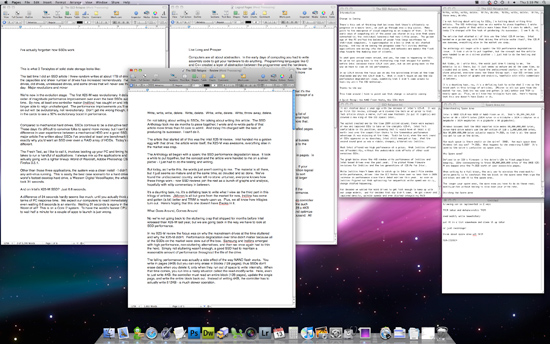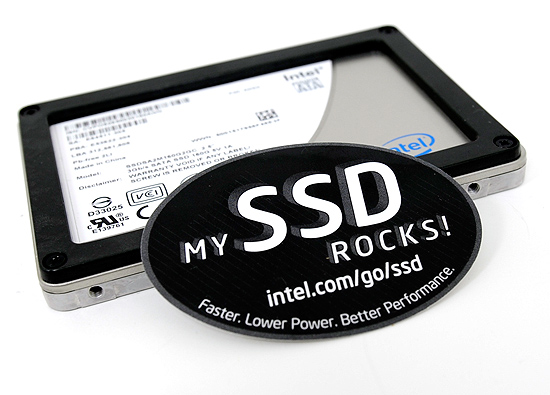Lab Update: The Next SSD Article, Matte vs. Glossy and Touch Screens
by Anand Lal Shimpi on August 21, 2009 4:48 PM EST- Posted in
- Storage
The SSD Relapse
I’ve been teasing everyone on Twitter with this for a while, but I’m really nearing close on the third installment of my SSD coverage. Right now I’m extensively testing TRIM on the major drives. Indilinx is the first out with official TRIM support...at least through a beta firmware. It’s currently enabled on both OCZ and Super Talent drives.

All of the text behind the next SSD article...just wait until you see the Excel sheet to go along with it
There are some limitations to TRIM. Currently the Intel Matrix Storage Manager drivers won’t pass the TRIM command through from Windows 7 to the drive’s controller. If you want TRIM to work at this point you need to use Microsoft’s drivers that come with Windows 7 (note that if you set Intel’s ICH to RAID, Windows 7 loads Intel’s MSM driver so that won’t work).
The benefit of TRIM is huge, your drive doesn’t get slower because of use, it only gets slower as you actually fill it. Intel was very careful/sneaky/shiesty to only enable TRIM on its 34nm drives. Real world performance is actually very similar between the 34nm and 50nm drives for desktop users. What makes the 34nm drive the clear buy is its support for TRIM.

I realize I haven’t said much about the 34nm G2 drives since their announcement, but Intel decided to sample after the announcement so I’ve been busy running these things through the ringer. Intel had to embarrassingly halt shipments of the drive to fix a BIOS password bug that resulted in data loss. I was actually quite surprised that Intel even let this one slip by but they’ve since put tests in place to ensure that it never happens again.
The most impressive advancements really come from the Indilinx camp. Not only has performance improved but Indilinx is actually the first to officially support the ATA8-ACS2 TRIM command. To show you the awesomeness of TRIM I've run a quick test. Here I ran my 4KB Random Write iometer script on a brand new, secure erased Super Talent drive sporting the 1711 TRIM firmware from Indilinx. I then filled the drive (simulating use over time), deleted the partition and benchmarked it again. Note that deleting a partition doesn't seem to trigger TRIM under Windows 7. You'll see that performance drops. Next, I formatted the drive (triggering TRIM) and rebenchmarked:
| SuperTalent UltraDrive GX 1711 | 4KB Random Write IOPS |
| Clean Drive | 13.1 MB/s |
| Used Drive | 6.93 MB/s |
| Used Drive After TRIM | 12.9 MB/s |
Pretty sweet huh? You'd get the same results from the Indilinx Wiper Tool, but this one happens automatically. You get nearly-new performance without doing a thing. TRIM is awesome. The firmware is available from both OCZ and Super Talent but I’d avoid it until it hits final. The Indilinx Wiper Tool is more than sufficient for your TRIMing needs for now.
The WePC Update
I’ve done some writing on a couple of things that have been on my mind lately. The first being Glossy vs. Matte displays on notebooks. It’s something I tackled last year but it’s still a worthwhile topic, especially given the attention Apple is getting. I should mention that Apple has since gone back to offering a Matte display option on its 15-inch MacBook Pros.
The other point of discussion is the future of touch screens outside of smartphones. Apple did a wonderful thing with the iPhone, but now the OEMs are struggling to figure out where touch (and multi-touch) is useful when it comes to notebooks and desktops. Help them figure it out.
Head over to WePC and check it out, leave ASUS/Intel your feedback and you may just see your opinions productized at some point :)
More Ion Cometh
Between the next SSD article and Lynnfield I'll find myself with a bit of time to tackle a look at current (and one upcoming) mini-ITX Ion platforms. My question to you is: is there anything we haven't covered with regards to Ion that you'd like to see in that article?










83 Comments
View All Comments
iwodo - Friday, August 21, 2009 - link
Well, what i like to see in SSD and ION. Basically the relate to Future.How are we ( or Intel ) is going to Scale SSD's performance? Indilix currently uses 2 - 4 Channel, Intel uses 10. But I guess using more channel would require more space, and it seems the current 10 channel 2.5" Intel using is already Max out by 10 Chip on a single Side. Using Newer OFNI 2.0 Chip will push the Raw Speed up to SATA 3.0 Max. But Random Read and Write, IOPS won't improve much at all without Getting More Channel chips like the Fusion IO.
Are we seeing going to hit performance wall soon with SSD?
ION - It may be wise to collect some Data now for HD decoding CPU usage. I read else where it is using much lower CPU usage then the upcoming Intel Core i3 with IGP.
What about the Future of ION? There are news with MCP 89 coming, I have been expecting Nvidia to use PCI-Express 2.0 to collect with their IGP. ( Which is just a GPU with Southbridge ) But how will it work with Core i3 with two GPU.
( And on the subject why is Intel Forcing us IGP when we dont want it, i just want a Cheap Westmere without IGP )
Looking forward to your article...
Gutcheck2009 - Friday, August 21, 2009 - link
So I bought a Patriot Torqx 64GB based on your article in CPU. I can still return it, does it support TRIM? I must say it is very fast.MadMan007 - Friday, August 21, 2009 - link
Yeah so touch interface is great for some things but tactile controls needn't be abandoned or seriously marginalized. I'm just afraid that with the 'coolness' of Apple touch iStuff that companies will feel forced to go touch as much as possible in order to not appear old fashioned.marks70 - Friday, August 21, 2009 - link
I don't see how it's evenly remotely acceptable for a drive to lose the amount of performance these SSD drives do after such limited use. Shouldn't this have been a major consideration when designing this technology? I know they're still faster than your typical hard drive even after they slow down, but should they really require this much intervention to keep them up to speed?The amount of "work" required to maintain these drives, in addition to their price, makes me questions if they are really ready for prime time.
sheh - Friday, August 21, 2009 - link
I hope the situation with HDD->SSD doesn't mirror what happened with CRT->LCD, a new technology superceding an older one before it has equaled or bettered it in all aspects.MadMan007 - Friday, August 21, 2009 - link
I don't see that happening because storage is much more of a 'background' thing than a monitor. You don't interact with it directly per se, you interact with programs that in turn use the storage. As long as they put out the same over the SATA interface the underlying details don't matter versus monitors where the underlying technology directly creats the user experience. And SSDs are already well on the way to being better all around than HDs aside from space.Mechanical drives will have a $/GB advantage for quite a while as well. It will be a good while until there are $200 2TB SSDs ;) plus mechanical drives might keep gaining density although it seems to have slowed a bit after the explosion thanks to perp recording. If it turns out that all mechanical drives are best at is massive space so be it. Maybe a return to 5.25" drives? lol
Rebel44 - Friday, August 21, 2009 - link
Thats 13MB in 4K random writes - almost all HDDs have less than 1MB in 4K random writes. :)JarredWalton - Friday, August 21, 2009 - link
Yup. It's pretty simple, really. For a 7200RPM drive doing 4K random transfers:Average seek time = ~12ms
Seeks per 1000ms = 83.3
Data transferred randomly in 1000ms = .326MiB
Switch to a faster 10K RPM HDD and you get:
Average seek time = ~8ms
Seeks per 1000ms = 125
Data transferred randomly in 1000ms = .488MiB
Or a super fast 15K SCSI setup:
Average seek time = 4.3ms
Seeks per 1000ms = 232.6
Data transferred randomly in 1000ms = .908MB
Basically, as long as you have to reposition the drive heads there is no possible chance for conventional HDDs to come anywhere near SSD speeds when doing random transfers. Unfortunately, there are a lot of instances when you have to do more or less random transfers. Defragmenting an HDD might get you up to 5MB/s on pseudo-random file accesses (i.e. "normal" use), but unless you're doing file transfers HDDs are really a bottleneck.
glugglug - Monday, August 24, 2009 - link
Your "seek time" calculations are just calculating the time it takes for the disk to spin around (which is part of *access* time, NOT *seek* time). Seek time is the time for the armature to move from one track to another. To get access time, which is what you are really interested in, the 2 numbers need to be added together.And the average time to spin to the right sector (once the appropriate track is located) is half of what you are quoting - needing to spin *all* the way around is worst case.
JarredWalton - Monday, August 24, 2009 - link
What I'm quoting is more or less approximate to average access time - half the rotational latency, plus a seek time that ends up being somewhere between the best-case and worst-case. The point isn't to be 100% exact, but to show how random access seriously handicaps performance of HDDs. If you were doing larger file accesses, the transfer rates are greatly improved - it's the small 4K random access pattern that's a killer for *any* conventional HDD. Even if you could get an HDD to 1ms average, you'd still be looking at 4MB/s compared to SSDs that are already hitting three times that rate.